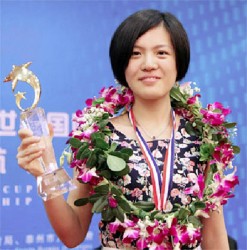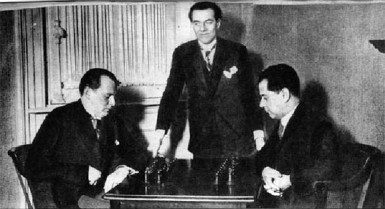The passed pawn is a criminal, who should be kept under lock and key. Mild measures, such as police surveillance, are not sufficient. – German grandmaster Aron Nimzowitsch, author of the perennial bestseller, My System.
China’s appearance in world chess has been as sensational as it has been sudden. The breakthrough began with the women chess players when Xie Jun won the world chess championship title in the nineties. China’s chess men are brilliant also, but it is their women who have reached the pinnacle of international chess stardom. It is only in the nineties that China entered our consciousness as a chess-playing nation, and at the turn of the century, a serious chess-playing nation.
At the 37th chess Olympiad in Turin, the men’s team came in second, and the women’s team third, for the best overall result among all participating countries. Chinese progress has been underpinned by large government support amid a number of testing competitions to sharpen player skills. There are approximately three million chess players in China, but Chinese chess [xiangqi] and go [weiqi], are still much more popular. China’s chess federation boasts a total of 300,000 members.
China is beginning to set itself apart because of how heavily it is investing in the development of its human capital. In chess, for example, the evidence is unambiguous, and as we say in Guyana, “as clear as daylight.’’ Hou Yifan, 19, won the World Championship title three weeks ago thereby becoming the fourth women’s world champion to emerge from China in the last 20 years. China has yet to produce the same sort of results among its men players, but it has two of the top seventeen in the world (Wang Yue at No. 14 and Wang Yao at No. 17) and given its resources, it is not difficult to imagine that it would soon have more.
 The New York Times has described Hou Yifan as “the face of China’’ owing to her resounding successes in the awesome mind game. In its 1,500 year history, we have to grudgingly admit that chess has embedded itself in the world’s culture and vocabulary. Ideas, terms and images from the game have long been used as proxies for intelligence and complexity.
The New York Times has described Hou Yifan as “the face of China’’ owing to her resounding successes in the awesome mind game. In its 1,500 year history, we have to grudgingly admit that chess has embedded itself in the world’s culture and vocabulary. Ideas, terms and images from the game have long been used as proxies for intelligence and complexity.
The Chinese women’s world champion, Hou Yifan, is by her own definition, an average university student. She attends the Peking University, one of China’s top schools. The difference in comparison to the average student, however, is that Hou is a confirmed chess prodigy. She has been ranked among the top 10 women chess players in the world since she was twelve. She became a grandmaster when she was fourteen, the 15th youngest in the world.
Guyana

I continue to stand by the view, therefore, that chess can complement a student’s academic accomplishments and prove to be a great asset in a student’s overall development. If China can make the lessons of the royal game available to its students, why can’t we follow suit? As it stands, there is no structure in place to appreciably enhance the promotion of chess for our students. Each December, the Ministry of Culture, Youth and Sport generously hosts a schools’ chess competition where students participate from as many as thirty odd schools. After they have received their trophies and medals they patiently wait for next December to do it all over again.
I humbly wish to contend that a grandmaster, (the highest title in chess), will only emerge from the school system. Inevitably, therefore, we have to take chess to the schools in a structured manner.

In local chess news, the National Junior Qualifiers competition begins this morning (Sunday) from 9 am at the Guyana Legion building, opposite Marian Academy on Carifesta Avenue. The tournament will continue next Saturday on October 5 at the Carifesta Sports Complex. The fee for entering the tournament is $600 for persons who are not members of the Guyana Chess Federation. Accredited members will pay a reduced entrance fee. Participants are reminded to bring their pens to keep score of their games.
The ten greatest masters
Please be reminded that in compiling this list of the ten greatest masters in history, Bobby Fischer based his final selection on the games of the players he has named, rather than on performances and credits earned. This could explain players like Lasker, Botvinnik, etc, not being mentioned. When questioned on this point, Fischer responded as follows:
“Just because a man was a champion for many years does not necessarily mean that he was a great player ‒ just as we wouldn’t necessarily call a ruler of a country ‘great’ merely because he was in power for a long time.’’
“The glamour boy of world chess, Capablanca, had been champion of Cuba at the age of 12, and from that time to his death in 1942 he had the totally undeserved reputation (as Petrosian does today) of being the greatest living endgame player. I recall a game Capblanca played Vera Menchek in which he made three colossal blunders, and that instance, while not quite typical, is that Capablanca didn’t know the simplest Rook and Pawn endings. The story is that he played over thousands Rook and Pawn endings but I cannot believe this to be true.
“Capablanca was among the greatest of chess players but not because of his endgame. His trick was to keep his openings simple, and then play with such brilliance in the middle game that the game was decided ‒ even though his opponent didn’t always know it ‒ before they arrived at the end.
“Capablanca never really devoted himself to chess, seldom made preparations for a match. His simplicity is a myth. His almost complete lack of book knowledge forced him to push harder to try to squeeze the utmost out of every position.
Every move that he made had to be super sharp so as to make something out of nothing. His play was forced. He had to try harder than anybody else because he had so little to begin with.
“He matured early and played his best games in his twenties. He was the only great Latin player ever to emerge on the world scene.’’




